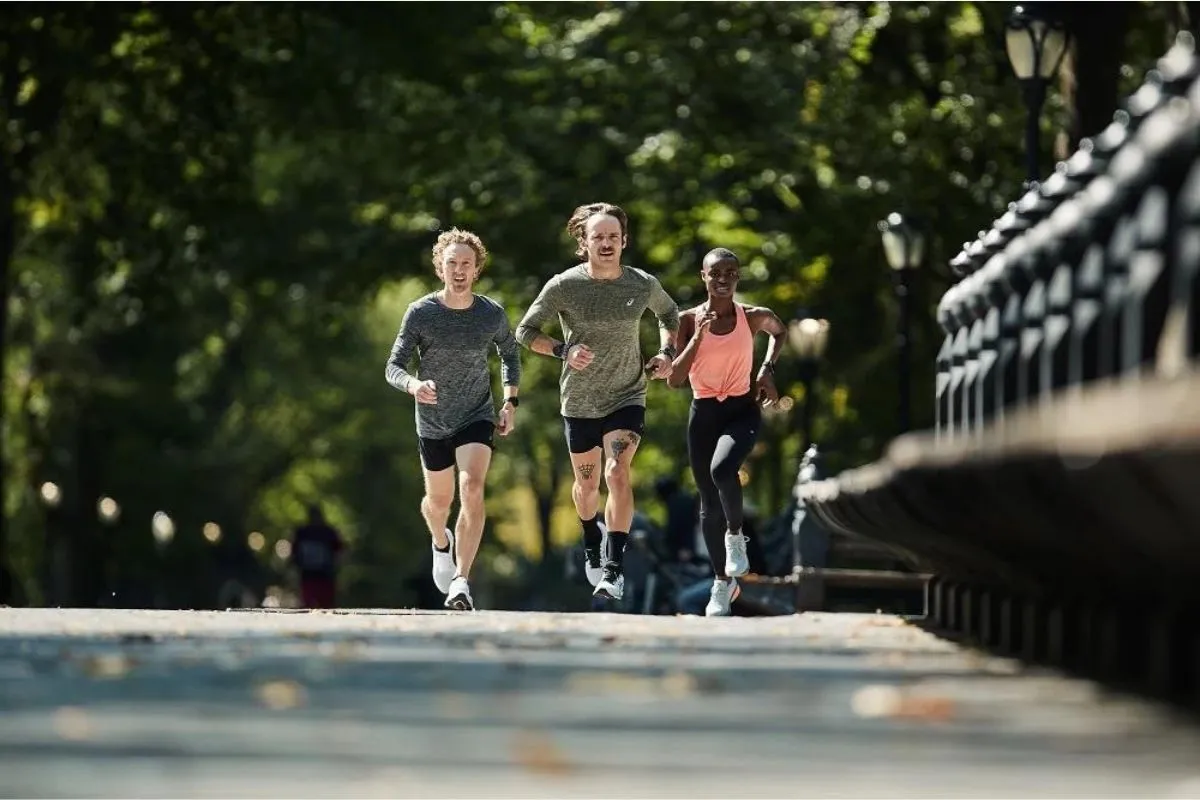Why Are Runners So Skinny? 3 Tips How not Lose Much Weight
Reviewed by: Ernesto Mendez (Orthopedic Clinical Specialist)
Have you ever wondered why are runners so skinny and have such flat stomachs?
It is no secret that running has many health benefits. But what is the specific connection between running and an individual’s body weight? This article will go over the link between running and body shape while providing expert tips on how to maintain your desired weight by engaging in this sport. Let’s dive in!
Running helps burn fat, builds muscle, and contributes to overall health and well-being. It mainly activates slow-twitch muscles, leading to a leaner body composition and toned legs. HIIT runs are the most effective method for weight loss, while long-distance runs improve endurance and develop a strong core.
How Running Affects the Runner’s Body: 3 Main Causes
So, why are runners so lean? It has been shown that endurance running mainly activates slow-twitch muscles, leading to the leaner, skinnier body composition commonly seen on elite runners. Running can also help you lose body fat while improving your fitness and increasing muscle mass. Let’s discuss these benefits in more detail.

1. Impact of Running on Legs
Running is one of the best exercises you can do to build strong, lean legs. As a full-body, weight-bearing aerobic exercise, it involves modulating impact and velocity while using all major muscle groups. Runners have skinny legs because running not only burns calories, but also helps strengthen your muscle tissues.
While running, both your quads and hamstrings contract with every step. The striding motion can tone long-distance runners’ legs by helping build muscle in certain areas, like around the hips and hamstrings.
2. Impact of Running on Abs
Running is a great activity for strengthening and developing the core muscles, including your abdominals. Running regularly can help to reduce excess belly fat that may be covering up those toned abdominal muscles underneath, making them more visible.
Depending on factors such as body fat percentage and muscle definition, it could take some time before you gain any visible effects of stronger abdominal muscles. But over time, you will notice positive changes.
3. Impact of Running on the Back
When running, the muscles in the back are engaged to maintain proper posture and balance. This can help to strengthen and tone these muscles over time.
Running can also help to alleviate back pain, particularly when it is caused by poor posture or weak back muscles. By strengthening these muscles and promoting proper posture, running can help to relieve pressure and strain on the back, reducing pain and discomfort.
Are All Runners Thin?
Though most runners have a lean figure, their body shapes and sizes can vary depending on the type and volume of running they do. Let’s take a closer look.
What Type of Running Leads to the Most Weight Loss?
One of the most common questions that runners ask is how to best use running for weight loss and which type of running yields the best results. HIIT runs are considered one of the most effective methods for losing a significant amount of weight in a short time.
HIIT involves brief periods of intense exercise, followed by recovery periods. This results in increased aerobic capacity due to improved muscle fiber utilization. On top of this, HIIT increases the metabolic rate during recovery periods, leading to more calories being burned over a longer period after each session. This provides better results compared with steady state cardio or moderate intensity workouts like jogging or walking.
1. Why Are Track Runners So Skinny?
A track runner’s body has a distinct composition that is characterized by a lean and thin physique and toned lower legs. This is because running leads to the depletion of glycogen reserves and consumes stored fat for energy.
In addition to developing stronger and firmer leg muscles, running also positively affects the abdominals and other core muscles.
2. Why Are Long-Distance Runners So Skinny?
The long-distance runner’s body expends a significant amount of energy, burning calories at an accelerated rate, which can lead to a higher baseline metabolic rate.
Endurance training also has the effect of increasing muscle tone across most major muscle groups. In experienced runners, one may observe increasingly toned arms, necks, chests, and even abdomens.
Subscribe to Our Running Newsletter!
Get free running tips from renowned professional athletes and discounts from top-notch brands.
3. Why Are Cross-Country Runners So Skinny?
Cross-country runners tend to have a slender, leaner physique due to the nature of their training. Constant aerobic exercise helps these athletes burn a high number of calories during long runs and gain muscle that results in the most efficient body shape for running performance.
High levels of endurance and muscular strength provide cross-country runners with amazing stamina that gives them an advantage on race day.
4. Why Are Marathon Runners So Skinny?
Marathon running consumes a large amount of energy and puts extreme stress on the muscles. Due to the fact that they often go into a caloric deficit, many marathoners have incredibly lean physiques with minimal body fat. The body weight loss associated with extended endurance runs can be attributed partially to glycogen depletion. Glucose is stored as energy in muscle cells. When it’s used up during a long-distance run, there’s energy to be converted into fat.

2 Main Reasons Why Runners Are So Thin
Here are some of the key factors that help keep runners thin:
1. Regular Exercise and High Metabolism
According to research, running burns more calories per minute than most other physical activities, like swimming, biking, or walking. The increased metabolic rate derived from running contributes significantly to maintaining a lower body weight, and also tones the muscles.
2. Nutritional Habits
Serious runners often focus on consuming a balanced diet of nutrient-dense whole foods such as fruits, vegetables, lean proteins, and whole grains.
Additionally, some dietary strategies are beneficial for specific goals. For instance, some athletes avoid carbs to stay fit, but have a carb load before races in order to increase their stamina during competition.
3 Tips How to Run Regularly Without Getting Too Thin
For many people, running can be a useful tool for achieving weight loss. However, its effectiveness in promoting weight loss may vary from person to person due to multiple factors, such as their individual body composition and metabolism.
Studies have shown that regular, moderate-to-high aerobic exercise like running can help reduce belly fat without needing to make any changes to one’s diet. But it is important to remember that losing weight through running requires an overall energy balance. After all, if a runner loses too much weight, they start to sacrifice muscle, which makes them slower and weaker.
It is definitely possible to regularly run without losing too much weight. To avoid getting overly lean from running, incorporate strength training sessions into your regular running routine. Also, make sure that you consume enough protein, as this helps with muscle recovery after workouts and supports overall health.
To minimize the risk of becoming too thin when running regularly, it may be necessary to focus on three main strategies:
1. Focus on Strength Training
To ensure both physical and mental health while running consistently, resistance and/or weightlifting exercises should be incorporated into the fitness routine. Doing so can increase strength and endurance and help you maintain a healthy weight.
2. Ensure Sufficient Protein Intake
For runners, protein helps build muscles for better workout performance and recovery afterwards. Many runners try to meet the recommended daily amount of protein (0.36 grams per pound of body weight). But in reality, this might not be enough protein for athletes such as runners, who need more to support their weight, activity level, and recovery after working out. Increase your protein amount to 0.5-0.9 grams per pound of body weight if you run regularly and want to maintain a healthy weight.
3. Consume Enough Calories
Runners, and particularly those who run competitively or for extended distances and times, need to ensure their diet is rich in carbohydrates. Carbohydrates are the essential macronutrient needed for energy production, maintaining weight, and sustaining strength during a run. Carbs top up the body’s glycogen stores, which can be used when completing an endurance-based workout.
Generally speaking, it is important to get enough calories each day to compensate for energy expenditure from physical activity. Calorie deficit will lead to reduced weight and a lack of fuel leftover after running to repair muscles properly.
Frequently Asked Questions About Skinny Runners
Why Do My Muscles Get Skinnier from Running?
When a runner engages in sustained aerobic exercise, the body depletes its glycogen reserves and begins to turn to stored fat for energy. This can lead to weight or muscle loss if not counteracted by proper nutrition and strength training.
Why Are Runners’ Arms So Skinny?
Long-distance and interval running depletes glycogen reserves and uses stored fat as energy, resulting in overall weight loss, which can include the reduction of muscle mass in the arms. In addition, some runners make the mistake of restricting the amount and type of calories they consume.
Final Thoughts on Skinny Runners
Being a runner generally leads to a skinny physique, but what makes runners slim isn’t as straightforward as it seems. While running does contribute to weight loss by burning calories and depleting glycogen stores, there are various other factors at play, such as genetics, lifestyle choices, diet, and training regimens.
If you want to maintain a healthy weight while running, you need to have sufficient calorie intake and add muscle-building exercises to your workout routine. This will allow you to maintain muscle density while still achieving maximum calorie burn rate in order to reach your fat-burning goals and target weight.
How do you maintain your weight while running? Please share your experience in the comments below.
Also read:
- Pace for 22 Minute 5K
- 18 Minute 5K Training Plan
- Running With Bronchitis
- How Many Minutes Is 2 Miles
- Creatine for Runners
- Run Slower to Run Faster
- Why Do My Legs Feel Heavy When Running
- 6 Week Training Plan For 10K
References:
- Muscle Fiber Type Transitions with Exercise Training: Shifting Perspectives // MDPI: https://www.mdpi.com/2075-4663/9/9/127
- High-Intensity Intermittent Exercise and Fat Loss // PMC: https://www.ncbi.nlm.nih.gov/pmc/articles/PMC2991639/
- Greater Weight Loss from Running than Walking during a 6.2-yr Prospective Follow-up // Medicine & Science in Sports & Exercise (MSSE): https://journals.lww.com/acsm-msse/Fulltext/2013/04000/Greater_Weight_Loss_from_Running_than_Walking.13.aspx
- Effect of Carbohydrate Content in a Pre-event Meal on Endurance Performance-Determining Factors: A Randomized Controlled Crossover-Trial // Frontiers: https://www.frontiersin.org/articles/10.3389/fspor.2021.664270/full
- How Much Protein Do RunnersNeed // Abbott: https://www.abbott.com/corpnewsroom/nutrition-health-and-wellness/how-much-protein-do-runners-need
- Carbohydrates and Endurance Exercise: A Narrative Review of a Food First Approach // MDPI: https://www.mdpi.com/2072-6643/15/6/1367
If you have any questions or suggestions, you can contact us via email – [email protected]






